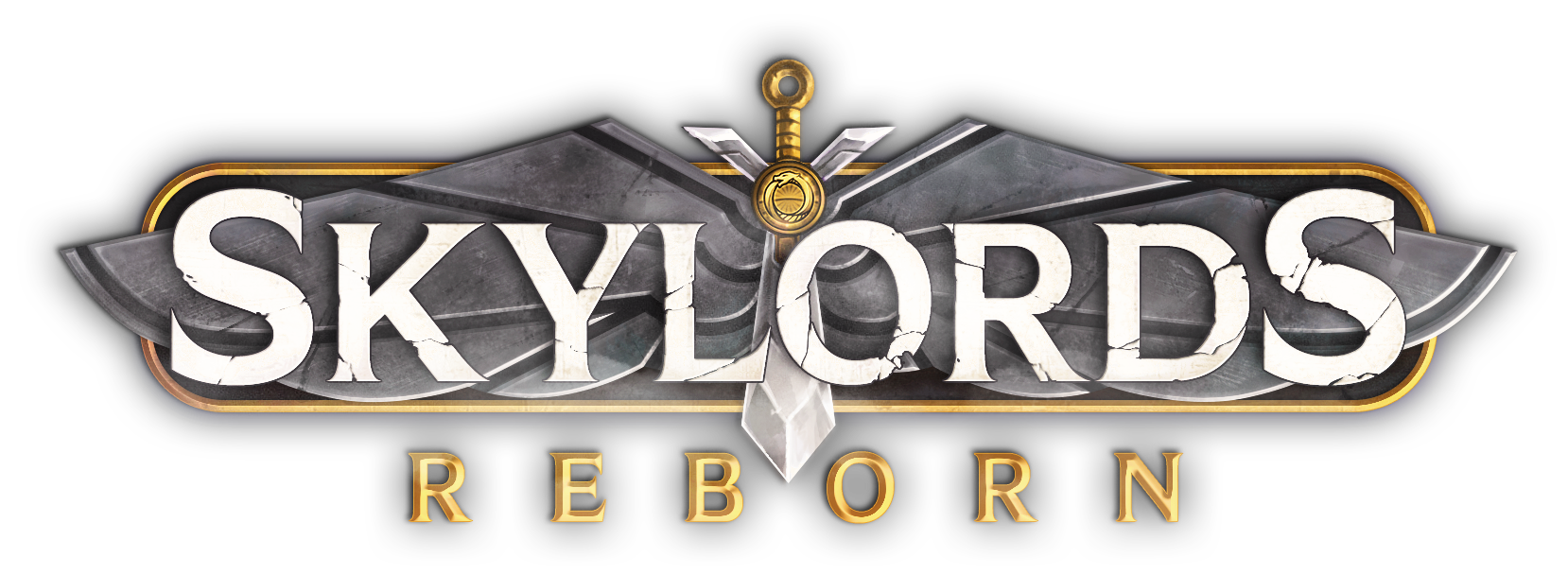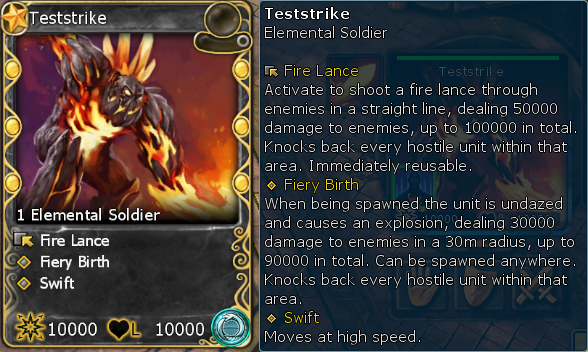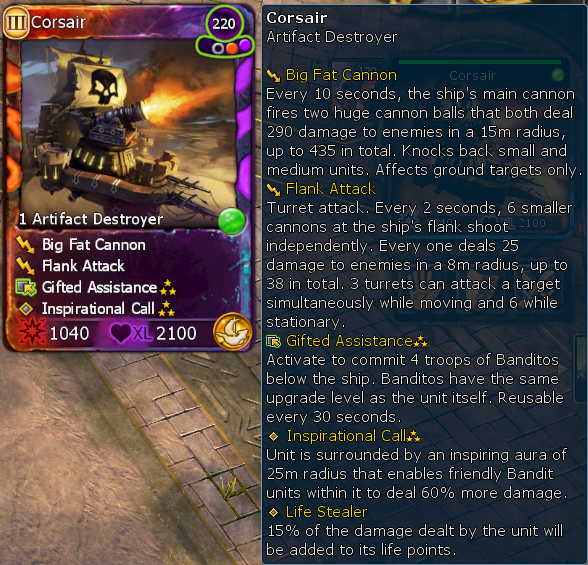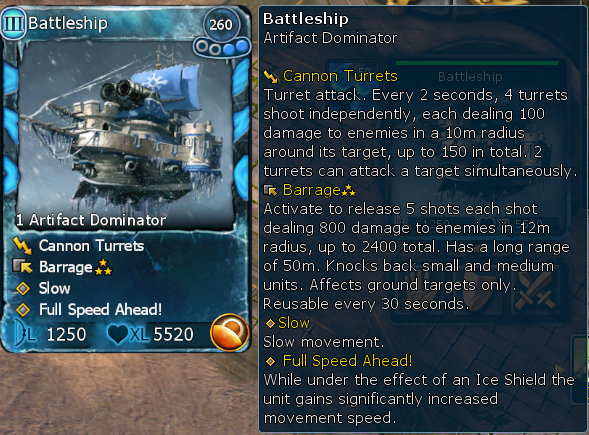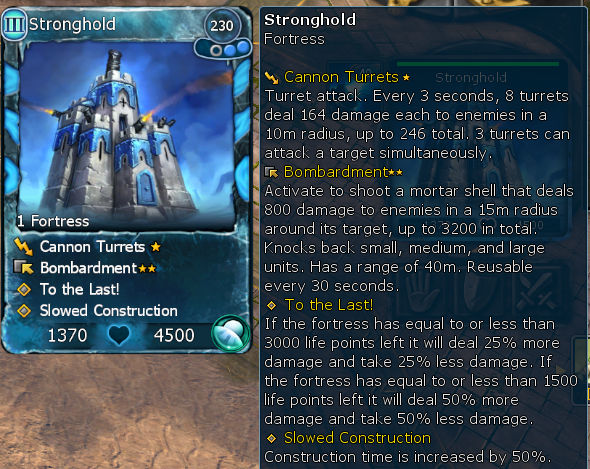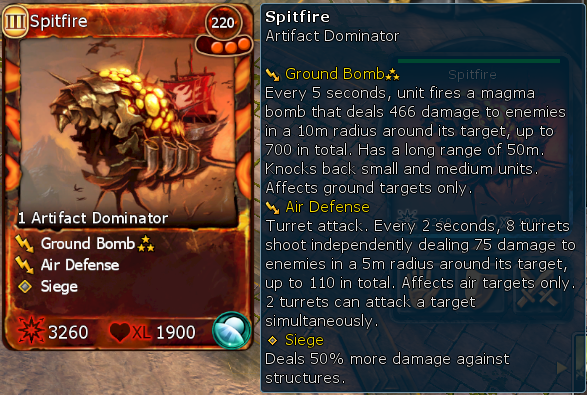-
Posts
441 -
Joined
-
Last visited
Everything posted by Cocofang
-
I think it is fine for Adv to be somewhat comparable to some cPvE Exp maps in difficulty. The game lacks challenging maps for veterans. But I would be in favor of adding a Std difficulty by simply swapping some LS and frost units for weaker ones and removing some from the attack waves. No special adjustments, just changes to units.
-
T4 cards are bad from what perspective exactly?
-
Massive props to the voice actors and audio editors. I implemented some of those and was really blown away by the professional-level quality. They fit extremely well and sound amazing, adding so much personality. Great voices, great effects.
-
Basically, if loads of value changes hands with no return it could mean one of two things: RMT, so someone paid real money or exchanged other things outside the game to receive the cards. Or multiaccounting, where a secondary account just dumps valuables onto the main account. So one-sided trades are always an eyebrow raiser.
-
Another hypothetical option would also be to create cards that are in spirit, for example, Twilight but one version is a T1 Fire card with Nature affinity while the other is a T1 Nature card with a Fire Affinity. That duo is then officially called a "Twilight" card but effectively you can pick between a Fire or Nature variant.
-
The patreon has been paused because it was only to cover the server costs and there is enough money to keep it running now.
-
Ironclad looks absolutely dope on the artwork but in-game it has a bunch of muted, muddy and ugly colors. Unfortunately, with limited capacity for artworks, it's a bit tricky to squeeze that inbetween some other priorities. But Ironclad specifically has been my pet peeve for a long time.
-
The new cards are continuously being tuned as we speak. So we'll see what kind of numbers they eventually hit live with. If, after release and everyone gets their hands on them, they turn out to perform in undesired ways they will receive a balance pass of course. Hopefully they'll be interesting in all sorts of compositions.
-
Right, right. So how is that game doing?
-
Nerfing the power cost does not solve the myriads of design issues the card introduces. All it would do is introduce extra waiting time. You could continue to increase the cost, adding more and more waiting time, until you reach a tipping point and the card becomes too slow to use at all. There is a difference between nerfing a card and punishing the player with boredom for using it. Unlike typical RTS games, Skylords is much more momentum based. Blocking void return could lead to a straight up match loss. And if you can disable Amii Monument to avoid that after playing your T4 army, then you'd still not have much incentive to play any T3 units and still stomp the T3 sections of a map with T4 units. A huge roster of cards remains overshadowed. And you'd still not fully address the problem of warping T1, T2 and T4 power because of the ability to free up deck slots and bulk up thanks to Amii. The core issues with the card are that it allows for a tier skip, with all the effects this has on deckbuilding and global card viability, and that it is neutral in combination with that. What would a poll regarding that matter tell you? That people don't universally enjoy nerfs? Mind-boggling revelation. Can you name me some other games that balance based on polls? Or any interview/presentation with a dev or designer that advocates for that practice? Could you think of any reason why that's not very common?
-
This change has no bearing on the feasibility of solo runs. All maps that you could solo before, you can still do after. Evidently you were already able to reach T3, that didn't change. And now you have an entire, newly buffed T3 roster to pick from. Additionally, a legacy server is planned that will serve as a permanent time capsule for the state of the game when it was originally sunset.
-
The characterization that the team is just unwilling to take some mythical solution that's great for everyone is so disingenuous. There was dissent but the reception to the Amii Monument nerf was noticeably more understanding and approving than for Enlightenment. A change that was ultimately shelved because the feedback was much different. It wasn't about Amii Monument or Enlightenment as individual cards. It was about tier skipping as a whole. The proposal essentially was not "Let's change these random powerful cards", it was "Let's change tier skipping". There was every intention to remove tier skipping from the game altogether so shelving the Enlightenment changes was the compromise. The concession has been made based on community feedback. One card is getting changed, the other is not. Tier skipping is staying in the game in the form of one of the most iconic cards while removing it from the cash-grab addendum.
-
It is obviously poking fun at the fact that this sort of argument can be flipped around on pretty much anything and is therefore ultimately vapid.
-
Skydancer has a mode where she grants extra base life to surrounding units, allowing Energy Core to survive the self-damage, as mentioned in the CU.
-
Mountaineer constantly builds up charges. But both the auto attacks and the shield consume charges. For the shield to active it needs to consume a full bar. It can never have a full bar as long as it is constantly attacking, since its auto attacks consume charges at a rate that prevents the bar from filling entirely. This has always been the case for Mountaineer, even during the original run of the game. The difference is that back then the mechanic was not explained at all, nobody knew it built up charges to attack and make a shield. So people just assumed the card was bugged when it couldn't attack after getting a shield.
-
Have you tried different graphic settings? SSAO is broken for me, for example. Leads to shadows flickering.
-
Yeah, well now that Spore Launcher has XL damage and more knockback it obviously got better in those isolated situations. In a lot of other situations you're still looking at an enormous difference in damage and versatility.
-
Each attack of Razorleaf has a damage potential of 1530 right out of the box. 1275 averaged. That is 5100 DP20. Without any support. Though the damage is spread out over a relatively big area so single target damage is usually only around 450-500. Fully supported it's 35700 DP20. Somewhere around 13000 DP20 on single targets. Plus artillery range and ability to hit air. Assuming Thornbark support and a Root Nexus you pay 530p for that. Breeding Grounds knocks that down to 405p. A fully supported Sporelauncher has 18375 DP20. Slightly higher single target of about 14700 DP20. That means Razorleaf is almost twice as strong. Plus is can hit air. Only downside being that with Root Nexus B it's "only" 4275 EHP, while Spore Launcher virtually cannot die.
-
Afraid of joining Expert lobbies because you have never played them before? Want to try a new deck but don't know how it'll work out? Would you like to train maps without the pressure of potentially failing your teammates? Really want to see for yourself if a certain card is worth the purchase and performs well? The Testserver got you covered! Introducing: This unit is exclusive to the Testserver and as you can see has insanely high stats. Not only that, it costs no power and can be played on T1 with any color. Additionally, it can be spawned anywhere on the map, regardless of ground presence. This means that using Teststrike, you can more or less remove certain parts of maps and only focus on training the ones you want to. Build your deck as you would normally but swap out one card for Teststrike. Want to train defending on position 1 or 2 of Guns of Lyr but are unsure which cards can hold for long enough and how quickly you have to progress? Spam a couple of Teststrikes around the fortress and they will kill anything that comes close. So you can focus on your own game. Unsure how to approach the difficult camps on Nightmare Shard? Lock one side of the shard down with Teststrike so you don't have to worry about fending off witches from that direction. Now you can experiment on how to free your T2. No idea how to either be quick enough or defend against the attack waves on Blight? Teststrike can nuke the other camps so you can put your own strategy to the test. Can you save the civilians in time on Titans or clear a path for Rogan before Jorne stomps him? Just let Teststrike do the tasks in the other sections of the map and get your position down. The only thing to keep in mind is that, as you start a map solo, certain wells and monuments that would be dedicated to other players on that map won't spawn. Maps that unfortunately cannot be trained solo are: Empire, Ascension, Passage to Darkness. So when you find yourself really struggling with a map, want to try a new deck or just get a closer look at certain aspects you can log onto the Testserver and give everything a go in a pressure free environment. Everything will get a lot less scary once you have a couple of reps under your belt and can confidently join an Expert lobby on Live, knowing that you can handle your position. You will learn a lot! How to access the Testserver Open your install directory of Skylords Reborn where SkylordsRebornUpdater.exe is located. Now, instead launch the game with LauncherTest.exe and you will connect to the Testserver. You will have to make a new account specifically for this server. This is a separate account and doesn't interact with your regular Live-server account. As such, progression with Achievements or anything won't carry over to the Live server. Speaking of which, on the Testserver you get 100m gold and BFP as well as all cards fully upgraded (may need to relog once to receive everything). Every now and then you might even catch a glimpse of a yet-to-be-released card! Happy testing!
-
Promise of Life seems like a purely reactive spell that you cast just as a unit is about to die. But you can use it proactive just as well. It has a rather long duration. So if you cast it on a unit before you go in and then let it die intentionally, you get it back without binding power.
-
Give Lost Dancer spam a chance. She can lay down crazy AoE damage because her impact area is massive. Unlike with a lot of other AoE ranged units you are pretty much guaranteed to benefit from her full damage in most situations.
-
I figured that these type of attacks could be keyworded as "Turret attacks" so that a line of consistency is drawn across all these entities. Then they could get the multishot-treatment. Meaning the DP20 of only a single turret is listed. In addition to that the description itself clarifies how many turrets can attack at the same time. It would look like this: Maybe "X turrets can attack one target simultaneously" would be clearer? "A single target can be attacked by X turrets simultaneously"? Thoughts?
-
Did you already do all the available ones right now or are there some Achievements that you just don't enjoy?
-
So for example, simply using the default formula would give those multi-turret entities the multishot treatment. In that they get a rather low DP20 printed value, however their tooltip description continues to read that several turrets fire simultaneously. That means people could do some napkin math and simply scale up the damage depending on how many turrets are firing. This would give us the following damage values for our outliers: Battleship - 1250 Ravenship (Ravenheart summons) - 760 Corsair - 1040 (formula for one turret and the cannon added up) Ravenheart - 1050 Spitfire - 3257 (formula for one turret and ground bomb added up) Lost Spirit Ship - 900 Howling Shrine - 1705 Rocket Tower - 375 Stronghold - 1367 Thunder Wagon - 5188 (turret plus flamethrower) Primeval Watcher - 5023 Now, I think the issue with this is that it somehow makes stock Stronghold look much weaker than stock Howling Shrine. Which I don't think is necessarily true. And it makes Ravenheart look as strong as Corsair. LSS weaker than Corsair. A more accurate determination of those cards firepower would only be revealed when looking at their extended tooltip. Which could be expanded by noting how many turrets can fire at a single target simultaneously to give people an idea on the effective single target damage. If we take this for example: Battleship - 2500 Ravenship (Ravenheart summons) - 1520 Corsair - 1670 (formula for one turret and the cannon added up) Ravenheart - 3150 Spitfire - 4182 (formula for one turret and ground bomb added up) Lost Spirit Ship - 1800 Howling Shrine - 1705 Rocket Tower - 375 Stronghold - 4100 We get something that I think is a bit more accurate to combat performance against single targets. But it once again muddies the waters when it comes to napkin math, as in people would still have to calculate the DP20 of one turret based on the tooltip and scale that up. And that formula would have the problem of double dipping on the AoE DMG part even though it's more tailored towards single target performance. And it leaves Howling Shrine too much in the dust compared to Stronghold. For strict consistency I am somewhat intrigued by the approach of using the Multishot presentation though. It is already an established approach within the game and would be very straight forward. At least assuming we also expand the tooltip to explain how many turrets can attack the same target simultaneously. Which is another problem to solve in and of itself, considering the weird behavior of Corsair and the fact that several multi-turret entities can sometimes shoot more or less turrets depending on the angle.
-
Some of you may be aware that the DP20 values that you find on ranged entities are not always reliable. While it is fine that they are rounded, some cards have values that are impossible for these cards to achieve. It's been a topic for some time and I started compiling all values the other day in order to finally tackle this problem with the goal of updating tooltips, DP20 values and formulas used to calculate those. Let's begin by establishing what works. Current formulas Generic The typical ranged attack in Skylords has an amount of damage it inflicts on the main target as well as an upper limit of damage it simultaneously inflicts in an AoE. And of course a time between attacks. There are different ways to write this and still come to the same result but it's essentially this. You take the damage the attack deals to a single target and add the total damage the attack can deal in an AoE. You then average that value out by dividing it by 2. Finally you take the time between attacks and divide it by 20 to get the amount of times the entity can attack within 20 seconds. Divide the previous result through this and you have your DP20. Alternatively divide 20 by the time between attacks and multiply the previous result by this. This formula works for the vast majority of ranged entities in the game. Unfortunately It just sometimes uses inaccurate values. Ranged attacks without AoE and Flamethrowers Used for any ranged attack that either does not have an AoE component or is purely AoE, in that the fixed damage value is distributed among all affected targets. In that case "time between attacks" should technically be "Interval between damage application" but same difference. Squads Used for ranged Squads. There are no ranged squads with AoE but if there were they would use the generic formula multiplied by the number of entities in the squad. You calculate the damage value as usual and then multiply it by the number of entities in the Squad. This is also the reason why damage output from a squad drops if individual squad members were killed. Inconsistent values Usually the AoE value of a ranged attack is 150% of the single target damage. So for example, an attack that deals 100 damage to the main target would consequently have an upper damage cap of 150 for its AoE. Pretty straight forward but unfortunately far from consistent. Many entities in the game are off by a few digits, so they range from 148% - 152% on their AoE. Some of them because the single target damage value doesn't have a clean 150% value, which is fine. The recently released Bedrock for example has 633 single target damage on U3, the AoE being rounded from 949.5 to 950. But in many other instances the numbers are simply off. For example, Armored Tower has 110-170 damage but really it should be 110-165. Another inconsistency is the attack time. After extensive testing there seem to be three internal values that define this. Cast Steps (the wind-up part of the attack animation after which the projectile fires), Resolve Steps (the wind-down part of the attack animation) and Recast Steps (independent balancing lever and cooldown between attacks), all expressed in milliseconds. The actual attack time appears to be: But take Cannon Tower as an example. It has 200 Cast Steps, 1000 Resolve Steps and 2300 Recast Steps. The highest value being Cast Steps + Recast Steps, which is 2500ms. But the description and DP20 calculation assumes an attack speed of 2000ms, or 2s. Which is of course completely wrong. Additionally, there is a small random delay added to every attack. This is an important aesthetic choice as it makes ranged battles feel much more frantic and organic. But it obviously affects DP20 and should be included in the calculation. Interestingly, this RNG delay doesn't affect entities that have higher Resolve than Recast Steps. Most airborne entities are in that category. Abilities As a general rule of thumb the DP20 calculation ignores abilities like Multishot or effects applied by the attack, like poison or debuffs that increase damage taken. Windweavers are notoriously powerful because their on-paper DP20 is doubled when they get to attack two targets. Same goes for Lost Horror or Rioter's Retreat. Other units like Gemeye P or Spirit Hunters have a powerful DoT attached to their abilities that drastically elevates their damage output. This makes some entities look worse on paper than they are. Going back to Spirit Hunters, their measly 192 DP20 is actually 792 or 692 depending on the affinity. And that doesn't even consider the ability to attack multiple targets one after another in order to apply the poison to several enemies simultaneously. For Gemeye P the actual DP20 is somewhere around 5250 instead of 3250. But that assumes targets stay within the AoE. Considering the huge variance it would introduce to DP20 calculations in addition to some affinity-variants getting different base stats they are simply not factored in. Sucks for cards that would get more attractive numbers but it's the most straight forward approach. Outliers This is where the real fun is. Ignoring abilities is simple enough but what if crazy variance is built into the attack itself? For these entities there is no established norm as to how to even approach the calculation. The formula has to somewhat reflect the expected damage output when using the card. But how? Let's look at all the relevant Outliers that are currently in the game and consider their damage output in various scenarios. Single Target: Only one target available Small AoE: Multiple targets available, all in one direction. Meaning while AoE is applied the same amount of turrets are active as if there was only one target. Split Single Target: Multiple targets available, surrounded. Meaning all turrets are active (where applicable) but no AoE is applied. Average AoE: Multiple targets available, surrounded. Average AoE overlap (Single Target DMG + AoE DMG) / 2) Max: Full damage application Battleship 4 directional turrets, each dealing 100-150 damage every 2 seconds. 2 turrets can attack a single target simultaneously. All turrets can attack if surrounded. Single Target: 2000 Small AoE: 2500 Split Single Target: 4000 Average AoE: 5000 Max: 6000 Ravenship (Ravenheart summons) 4 directional turrets, each dealing 70-120 damage every 2.5 seconds. 2 turrets can attack a single target simultaneously. All turrets can attack if surrounded. Single Target: 1120 Small AoE: 1520 Split Single Target: 2240 Average AoE: 3040 Max: 3840 Corsair 6 directional turrets, each dealing 25-38 damage every 2 seconds. 3 turrets can attack a single target simultaneously. Except when the Big Fat Cannon cycles through. At which point all 6 turrets can attack a single target simultaneously. All turrets can attack if surrounded. Single Target: 1125 Small AoE: 1417 The above values are already wonky because they assume 4.5 turrets firing, as the average between the 3 drive-by turrets and all 6 blasting while Big Fat Cannon cycles. Split Single Target: 1500 Average AoE: 1890 Max: 2280 Big Fat Cannon (regular formula) Single Target: 580 Average AoE: 725 Max: 870 Ravenheart 6 directional turrets, each dealing 90-120 damage every 2 seconds. 3 turrets can attack a single target simultaneously. All turrets can attack if surrounded. Single Target: 2700 Small AoE: 3150 Split Single Target: 5400 Average AoE: 6300 Max: 7200 Spitfire 8 directional turrets, each dealing 75-110 damage every 2 seconds. 2 turrets can attack a single target simultaneously. All turrets can attack if surrounded. Only affects air targets. Regular ranged attack with an AoE component, dealing 466-700 damage every 5 seconds. Only affects ground targets. Single Target: 1500 Small AoE: 1850 Split Single Target: 6000 Average AoE: 7400 Max: 8800 Ground Bomb (regular formula) Single Target: 1864 Average AoE: 2332 Max: 2800 Lost Spirit Ship 8 directional turrets, each dealing 80-100 damage every 2 seconds. 2 turrets can attack a single target simultaneously. All turrets can attack if surrounded. Single Target: 1600 Small AoE: 1800 Split Single Target: 6400 Average AoE: 7200 Max: 8000 Howling Shrine 4 directional turrets, each dealing 750-1125 damage every 11 seconds. 1 turret, rarely 2, can attack a single target simultaneously, depending on positioning. All turrets can attack if surrounded. Single Target: 1705 Small AoE: 2131 The above values assume 1.25 turrets firing. Split Single Target: 5455 Average AoE: 6818 Max: 8182 Primeval Watcher Chain attack dealing 660 - 330 - 220 - 165 - 132 damage as it affects up to 5 targets. Can only hit each target once per attack. Single Target: 4400 Second Target: 2200 Third Target: 1467 Fourth Target: 1100 Fifth Target: 880 Max: 10047 Rocket Tower 4 omni-directional shots, each dealing 75 damage every 4 seconds. Cannot attack a single target simultaneously. Can shoot all if 4 or more enemies are in range. Functionally similar to Multishot. Single Target: 375 Max: 1500 Stronghold 8 directional turrets, each dealing 164-246 damage every 2 seconds. 3 turret, rarely 4, can attack a single target simultaneously, depending on positioning. All turrets can attack if surrounded. Single Target: 3553 Small AoE: 4442 The above values assume 3.25 turrets firing. Split Single Target: 8747 Average AoE: 10933 Max: 13120 Thunder Wagon 1 turret, dealing 350-525 damage every 4 seconds. 1 flamethrower dealing 150 damage every second. Thunder Bomb (regular formula) Single Target: 1750 Average AoE: 2188 Max: 2625 Flamethrower (regular formula) AoE: 3000 What now? A big problem with some of these outliers it the drastically different damage output depending on how many turrets can shoot at any given time, as they are directional. How do you account for that sort of variance in a static formula? Thunder Wagon is the most straight forward with its current design: Just add up the two AoE values. Rocket Tower could get a nasty low number like 375 DP20 or the rounded average between single target and max, which is 940. There can be different formulas depending on the setup but ideally several outliers should be covered by one formula. The questions to solve are: Once the RNG delay is considered in the DP20 calculation, many ranged entities will end up with a lower DP20 value. This wouldn't affect their functionality at all though. Would that still be something to be concerned about? Should the relation between single target and AoE be updated across the board to get as close to 150% as possible? Which formulas could express the DP20 value of the outlier cards most accurately? They are clearly more tailored towards AoE clearing but a needlessly inflated DP20 value would give a false impression about their actual strength. Do the outliers need expanded tooltips to clear up their mechanics or is the DP20 value enough? How should the DP20 value be rounded? Single digit? Even 10? Even 100? Different rounding depending on the tier of the card? Important to keep in mind that this is all just about the visual representation of numbers. The actual mechanical values are untouched (aside from potentially minor changes to achieve the 150% AoE value). But depending on which formulas you use you get a higher or lower number printed on the card. Which is certainly important for the "feel" and first impression. If you have any ideas or opinions regarding this topic, feel free to share. Especially potential formulas for the outlier cards that can be used going forward would be valuable.
